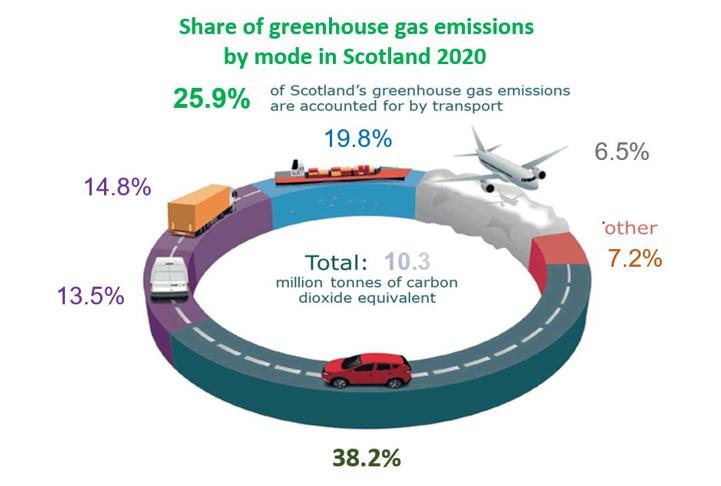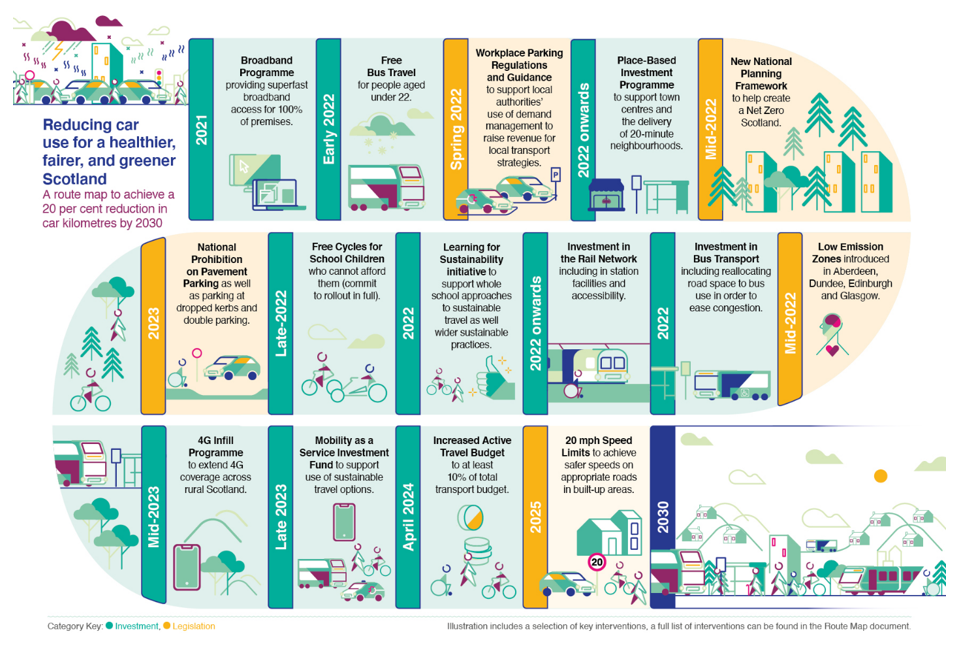20% reduction in car km by 2030
Transport is Scotland’s biggest contributor to climate change, emitting over a quarter of all of our greenhouse gas emissions. Within this, the largest share of transport emissions comes from cars, accounting for around 40%. The predominance of private car use, therefore cannot be overlooked. Scottish Government’s Climate Change Plan update in 2020 included a commitment to reduce car kilometres by 20% by 2030 (against a 2019 baseline). By rethinking how we use our cars and reducing the number of daily journeys we take, we can help make Scotland a healthier, fairer, greener place to live and significantly contribute towards Scotland reaching net zero.
The following graphic shows an illustrated pie chart of greenhouse gas emissions by transport mode in Scotland in 2022. Total emissions from transport were 12.9 million tonnes of CO2 equivalent, with cars having the highest proportion of emissions at 39%, followed by HGV and vans combined at 27.3%. Aviation is at 12.2% and shipping at 15.2% in 2022. The remainder 6.3% is from other transport.

The need for change
Our National Transport Strategy (NTS2) outlines the need to reduce travel by unsustainable modes and sets out the sustainable travel hierarchy, where walking, wheeling and cycling are the preferred modes for shorter journeys. The UK Climate Change Committee’s Sixth Carbon Budget report also acknowledged the need for car use reduction, and the important benefits, both for the climate as well as for the health and wellbeing of Scotland’s citizens.
Research commissioned by Transport Scotland and undertaken by Element Energy, looked at options available to meet Scotland’s statutory climate targets. The report concludes that technology alone will be insufficient to meet out net zero target by 2045 and that we need to reduce the use of private vehicles as well as supporting a transition to lower emission vehicles, for those journeys where private car is still required.
Our national commitment to reduce car use deliberately includes all types of car, including electric vehicles, in recognition of the wider benefits of a society less-dominated by the movement and storage of private vehicles. These benefits include reduced road danger; reduced air and noise pollution; increased opportunity for physical activity through active travel; reduced community severance; reduced congestion; and the revitalisation of local high streets, town centres and communities as places for people not vehicles. Reducing overall car use is particularly important in light of our commitment to a Just Transition to net zero emissions, recognising that the negative impacts of car use fall disproportionately on some of the most vulnerable and disadvantaged groups in society, despite the fact that these groups are less likely to have access to private vehicles. We are however committed to maintain access by car for those who need it, such as though who use cars as a mobility aid.
A holistic behaviour change approach - The ask
On 13 January 2022, we published our route map to achieve a 20 per cent reduction in car kilometres by 2030, which was developed in partnership with CoSLA- The Confederation of Scottish Local Authorities.
The route map makes use of behavioural change theory and identifies four sustainable travel behaviours for everyone in Scotland to consider each time we plan a journey, setting out a range of transport and non-transport interventions that will help them to adopt these behaviours.
These behaviours are:
- make use of online options, where appropriate, to reduce the need to travel
- choose local destinations to reduce the distance travelled
- switch to walk, wheel, cycle or public transport where possible
- combine a trip or share a journey to reduce the number of individual car trips made, if a car remains the only feasible option.
Just transition considerations run through the route map and we do recognise that different behaviours will be more feasible in different geographical locations and for individuals with different needs. This is a national ambition – it does not mean car use in rural and remote areas is expected to drop at the same rate as towns and cities. Given that the 20% reduction commitment is a Scotland-wide figure, it will obviously require geographical variations. We also recognise that the opportunities to reduce car use in remote rural areas are much reduced and therefore, switching to electric vehicles will be of higher importance in those areas.
But wherever you live in Scotland, fewer cars can also make roads and streets safer, especially for children, and create healthier and happier communities, where people and businesses can thrive and enjoy better quality spaces
Interventions to support change
Given that transport is a derived demand, this reduction will require cross-sectoral effort which goes beyond transport and will need all parties to use the levers they have at their disposal.
The draft route map contains over 30 interventions, with a number of key interventions, to support people to adopt one or more of the sustainable travel behaviours outlined in the graphic below. It also includes a commitment to conduct further research in equitable demand management. In December 2024, this research was published alongside a context and policy position statement.
We recognise that Scotland has still got some way to go to transition from private vehicles and towards more sustainable public transport – and cross party support at all levels of government is key. The 2025-26 budget invests £263 million in sustainable travel, low carbon and climate positive activities to support the switch to zero emission vehicles and promote walking, wheeling and cycling for everyday shorter journeys.
Cabinet Secretary for Transport noted to Parliament on 6 March 2025 that, as reported in May 2024, the 20% car use reduction target is not on track and at risk of not being met. The Scottish Government has therefore decided to conduct a review a review of the 20% by 2030 target for car use reduction, informed by the forthcoming Climate Change Committee advice in May 2025, to develop a new, longer-term target aligned with the development of the draft Climate Change Plan. We will also jointly publish with COSLA a renewed policy statement on car use reduction in spring 2025.

Interventions referred to in the graphic above are described in more detail in our draft Route map publication.
Just transition
The route map is underpinned by our commitment to a just transition to zero greenhouse gas emissions, creating benefits and opportunities equally for people across Scotland.
Ensuring more people choose active and sustainable travel will not only result in fewer emissions, but can also promote healthier lifestyles and better equality of access to transport.
The status quo is unfair. For people on the lowest incomes, 60% have no access to a car. Of those with a long-term health problem or disability, the figure is 46%. Younger and older people, women and certain minority ethnic groups are also less likely to have access to a car, including in rural areas. The figures are even starker for multiple car households. 71% of households in the highest income brackets (over £50,000) have access to two or more cars; for those in the lowest income bracket (under £10,000) the figure is 8%.
People in low-income households are more likely to travel by bus, while those in higher income households are more likely to travel by car, a trend that has been exacerbated by COVID-19.
Therefore the resurgence of a healthy bus network in our recovery from COVID-19 is vital to securing a just transition and delivering our vision for a sustainable, inclusive, safe and accessible transport system. Helping to give people access to bikes and e-bikes, particularly in areas of multiple deprivation, can drive equality and promote physical activity.
We acknowledge that reducing private car use will be more challenging for people in who live in rural areas or who currently have no other affordable option. As such the framework of sustainable travel behaviours is designed to be applicable in both rural and urban settings as well as for those with a variety of transport mobility needs. The aim is to empower people to choose an option that fits their circumstances and trip-purpose needs. Ensuring that people can reduce their need to travel by car whilst still having affordable access to employment, goods and services will be key to achieving this outcome without having a detrimental effect on equality.
We will continue to consider a range of issues in relation to the route map, such as the availability of public transport alternatives, low income and inequality implications, and geographical considerations, through the on-going consultation and impact assessment process.
The benefits
The negative impacts of an over reliance on the car, including road traffic congestion, are experienced by everyone, regardless of whether they are able to enjoy what are considered as benefits of car use.
Not only will reducing car use have a significant impact on emission, a society less reliant on cars will contribute to improved public health, through increasing opportunities for active travel. As well as, helping to improve air quality and safety – issues that disproportionally impact on the less fortunate in our society.
Towns and cities will have more space available to be reallocated to pedestrians, cyclists and public transport, helping create more inclusive and attractive public spaces. Favouring more sustainable transport can also promote social inclusion, particularly for households for which the cost of car ownership and use acts as a barrier to accessing employment, education and key services.
Find out more
- Read our publication - A route map to achieve a 20 per cent reduction in car kilometres by 2030